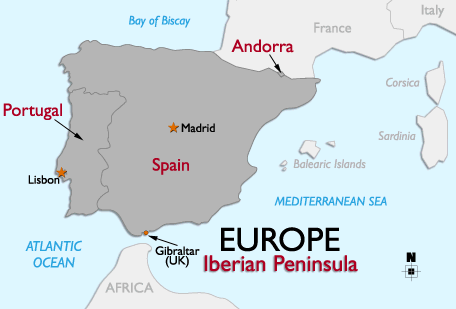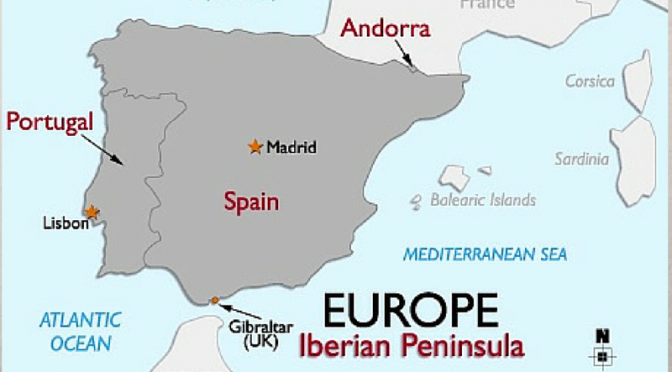Little has changed in the last 600 years with regards to war – they’re still fought over territorial power. So it was with the Battle of Aljubarrota, one of Portugal’s most important battles.
Introduction – Identity and Territory as a Catalyst for War
The Spanish and the Portuguese are old enemies. If you look at the map of the Iberian Peninsula you will understand why.

It is interesting to note that underlying the fight for territory is the desire to preserve national identity. In that, both nations wanted the same thing. It is sad that they needed to destroy the other in order for their identity to be preserved.
Even sadder is the close correlation between identity and territory, as though the soil, rivers and mountains retain the DNA of of a people.
This post will cover the main highlights and is by no means exhaustive.
The Crisis of Succession
The protagonists:
- King Ferdinand I of Portugal, whose death without a male heir sparked off the crisis
- Queen Leonor, his widow who became the country’s regent until the rightful heir (as yet unborn) could assume the throne
- Beatrice, daughter of Ferdinand and Leonor
- King Juan I of Castile, and husband of Leonor
- John, Master of Aviz, Ferdinand’s half-brother, not a supporter of Castile, and later king John I of Portugal
- Count Andeiro, Queen Leonor’s main counsellor, murdered by John
- D. Nuno Alvares Pereira, hero of the battle of Aljubarrota
The action:
Ferdinand died in 1383 without a male heir to inherit the throne. In April of the same year he had signed a treaty with Juan arranging the marriage of his daughter Beatrice to Juan. It further arranged that the crown of Portugal would belong to their descendants.
The Portuguese people were not happy with state of affairs as it meant that the Castilian king would effectively inherit the Portuguese throne, thereby allowing him to enforce Castilian rule on Portugal – a bloodless coup, a country handed over on a platter.
This treaty was also signed without consultation with the rich and powerful merchants of Portugal. All of this threw the country into turmoil and marked the start of the crisis of succession. In the meantime, Leonor, became the country’s regent.
John, against this status quo, killed Leonor’s main counsellor, Andeiro, to undermine her power and by extension, the power of Juan. So Juan invaded Portugal and lay siege to Lisbon. Discord amongst Juan’s army and the bubonic plague put an end to this siege and the Castilian army retreated.
John became the hero of the Portuguese people which enraged Juan, so he invaded Portugal AGAIN! After the the battle of Atoleiros which the Portuguese won, John ascended the throne of Portugal and became king.
The Battle of Aljubarrota
As the Spanish army is marching on Lisbon, D. Nuno Alvares Pereira not wanting to wait around for them to arrive decided to meet them half-way.
At the time England was one of Portugal’s allies and amongst the Portuguese army were many English knights. On August 14, 1385 the Portuguese won this battle through good strategic planning, use of high ground and a a tactical military manoeuvre, the infantry square, which caught the Castilians by surprise even though they outnumbered the Portuguese army.
The denouement:
This battle was important because it assured Portugal’s continued independence from Castile (which in time became Spain). This led to John, Master of Aviz’s being the undisputed King of Portugal, and thus began the rule of the House of Aviz.
Amazingly, the alliance between Portugal and England led to the two countries signing the Treaty of Windsor, committing both nations to mutual support. This diplomatic alliance, signed in 1386, still stands today. Historian Matthew Winsett says, “This treaty has been the cornerstone of both nations’ relations with each other ever since.”
This treaty was sealed by the marriage of John, to the Duke of Lancaster’s daughter, Philippa of Lancaster. One of their three sons, Henry the Navigator, went on to sponsor Portugal’s expeditions overseas and the initiator of the Age of Discoveries, effectively assuring Portuguese supremacy over the seas for many centuries.
References:
- Saraiva, Jose Hermano (2003). Historia Concisa de Portugal (22ª EDIÇÃO). Publicacoes Europa-America.
- Wikipedia – Battle of Aljubarrota
- Wikipedia – Treaty of Windsor (1386)
- Wikipedia – Henry the Navigator
- Wikipedia – List of Portuguese Monarchs
Discover more from Wide Eyed In Wonder
Subscribe to get the latest posts sent to your email.

I must learn… 😉
Hehehe 🙂